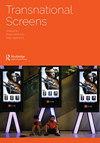超越人类的世界通过新西方景观的Jauja和荒野猎人
IF 0.4
0 FILM, RADIO, TELEVISION
引用次数: 0
摘要
摘要本文运用后人文主义和生态批评的思想,对利桑德罗·阿隆索的《黑鬼》和亚历杭德罗·González Iñárritu的《荒野猎人》进行比较研究。这种比较有助于探索叙事和美学策略,通过这种策略,人类尺度的事件被去中心化,殖民历史被修正,当地方感被理解为超越和重建人类,构建电影对象时。这两部电影表现了欧洲和美国人民之间的相遇,但也许更重要的是,它们表现了他们在超越人类的世界里的相遇,这种世界破坏了殖民主义制造世界的控制叙事。然而,在乔贾的《巴塔哥尼亚》中那种难以理解和冷漠与《荒野猎人》中那种寒冷而脆弱的崇高之间,还是有区别的。本文讨论了这些差异在电影可能性方面的影响,以重新想象殖民边界的具体景观,将殖民历史与掠夺者的现在和不同的未来联系起来-无论是灾难性的还是创造性的-它预示着。本文章由计算机程序翻译,如有差异,请以英文原文为准。
More-than-human worlds through the Neo-Western landscapes of Jauja and The Revenant
ABSTRACT This article applies ideas from posthumanism and ecocriticism to a comparative study of Lisandro Alonso’s Jauja and Alejandro González Iñárritu’s The Revenant. This comparison serves to explore the narrative and aesthetic strategies by which human-scale events are decentred and colonial histories revised when the sense of place understood in terms going beyond and recreating the human, structures the cinematic object. These two films represent encounters between European and American peoples, but perhaps more significantly they represent them within more-than-human worlds that destabilise the narratives of control underpinning colonialist world-making practices. There is, however, a difference between the impenetrability and inhospitality of Jauja’s Patagonia and The Revenant’s wintry but fragile sublimity. This article discusses the implications of these differences in terms of cinematic possibilities for the reimagining of the concrete landscapes of colonial frontiers to link colonial histories to the extractivist present and the different futures – both catastrophic and creative – it presages.
求助全文
通过发布文献求助,成功后即可免费获取论文全文。
去求助
来源期刊

Transnational Screens
Arts and Humanities-Visual Arts and Performing Arts
CiteScore
0.60
自引率
0.00%
发文量
23
 求助内容:
求助内容: 应助结果提醒方式:
应助结果提醒方式:


